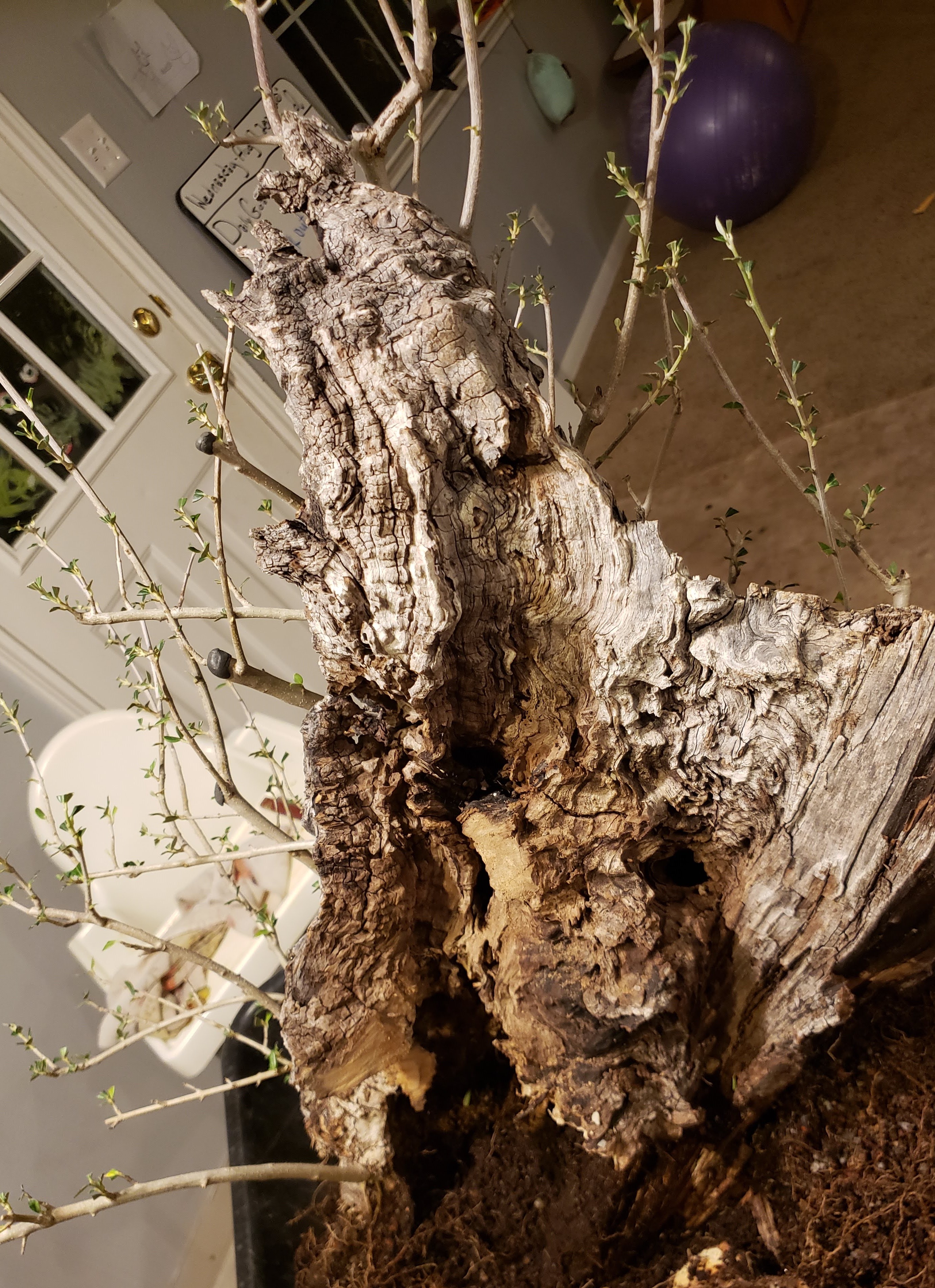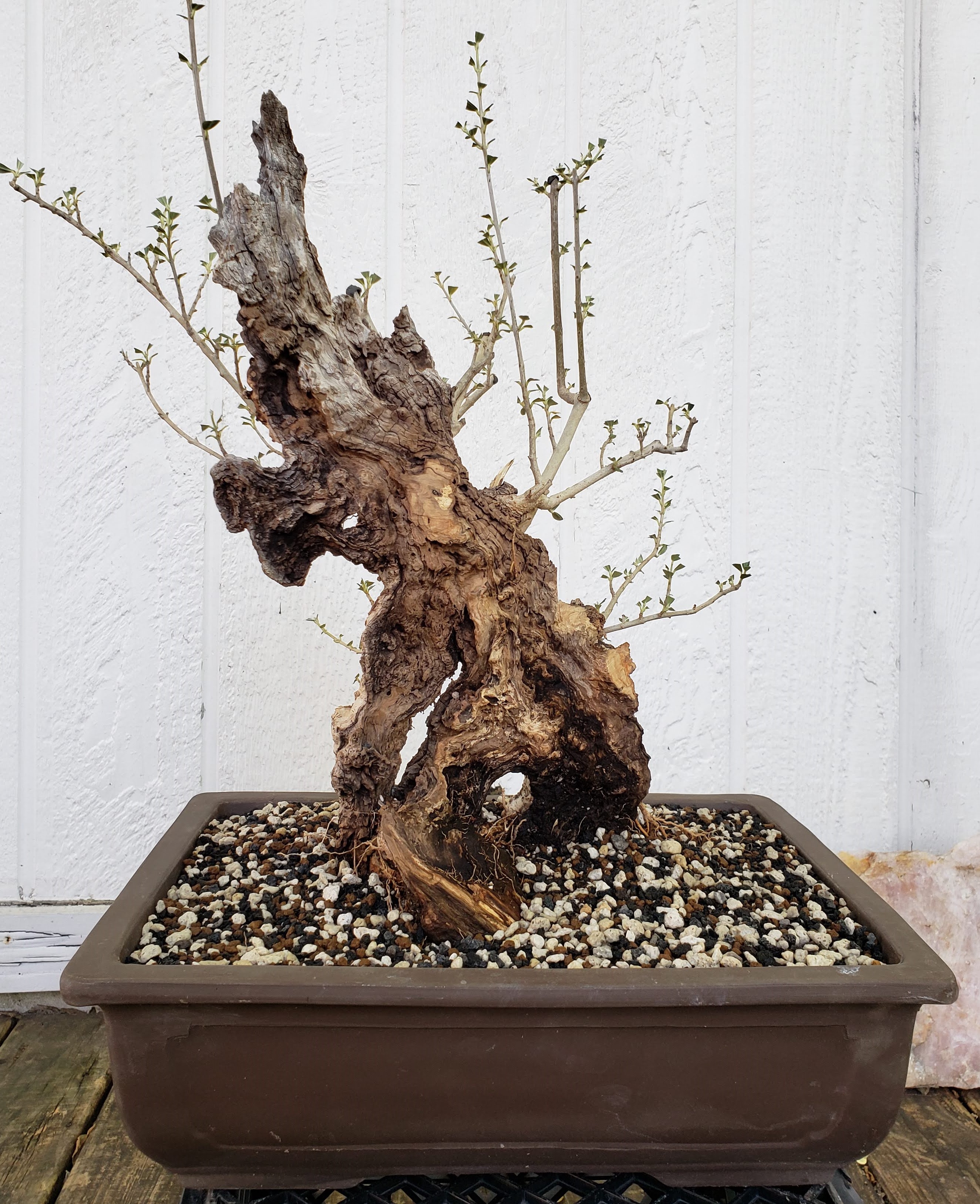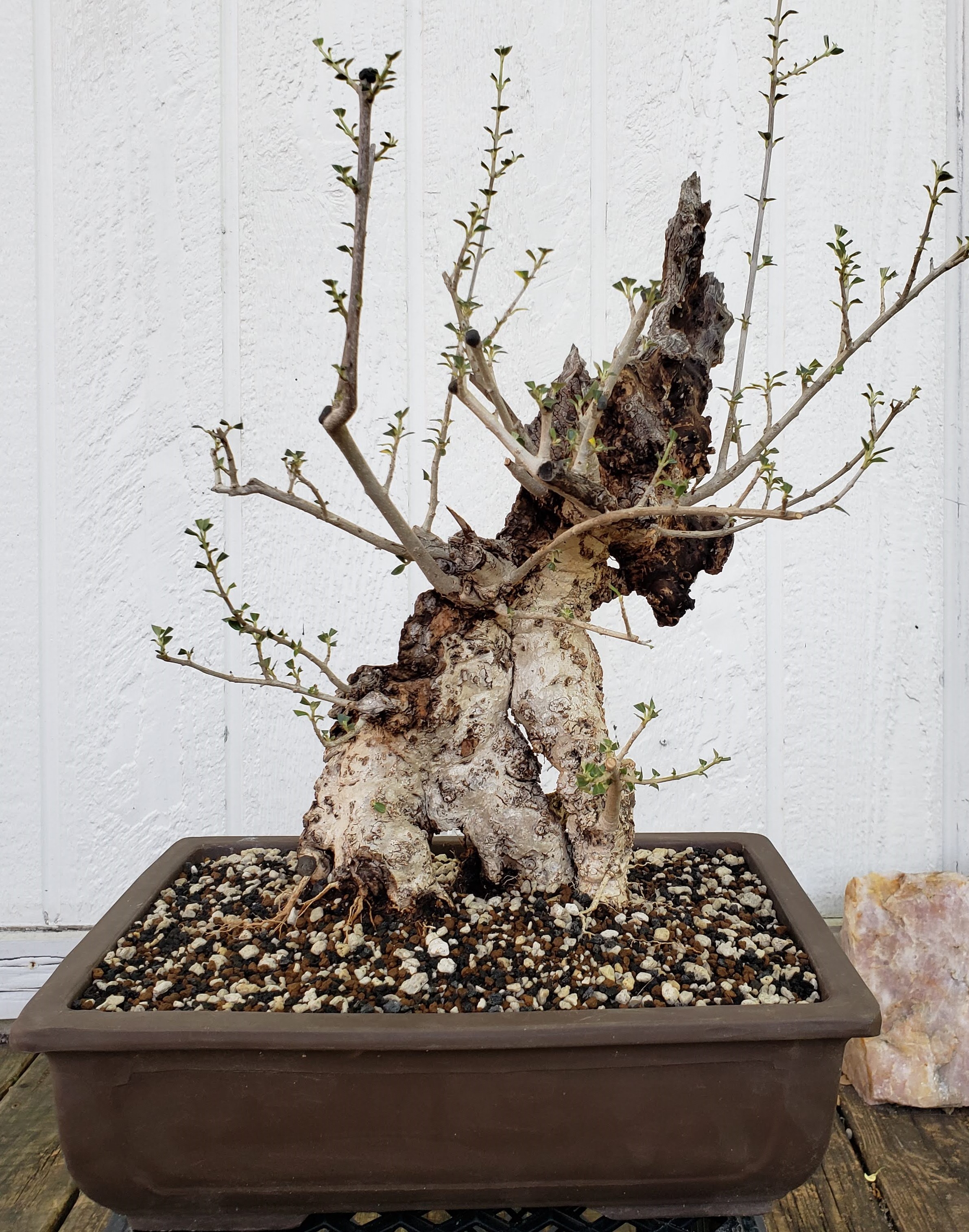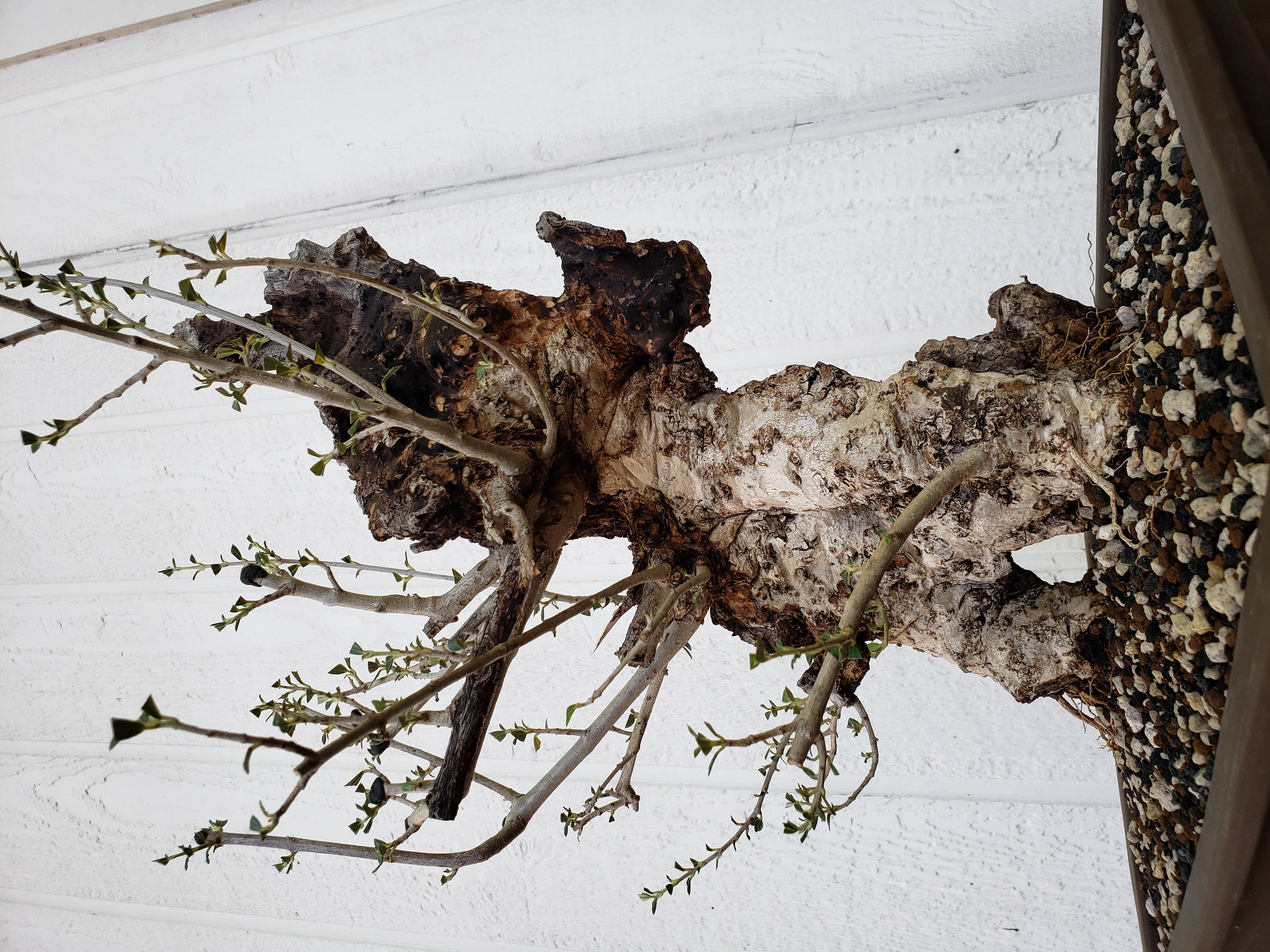 Photo by Brandon Baldauf | @wizardsknow
Photo by Brandon Baldauf | @wizardsknow
Styling a Yamadori Olea - "Demi-Tree"
A blog post by Brandon Baldauf for Hawk Eye BonsaiWhile exploring styling options for an imperial sized yamadori Olea specimen, it quickly turns into a wild and unexpected ride finding a twin flame tree!
Above and below you will see two before pictures of the yamadori Olea specimen. This Olive tree was collected by Satoyama around 15 years ago in California. Since then, the current branching has been growing out to get to the desirable caliper, or thickness.
When found in the field, there was no active growth on the trunk, Olea bonsai can take a long time to cultivate proper proportioned branches with respect to the presence of the deadwood features. It really depends on the style you are aiming for...
 Photo by Brandon Baldauf | @wizardsknow
Photo by Brandon Baldauf | @wizardsknow
After studying the tree with the intent to style it, I explored a variety of fronts and options. There are two large points of deadwood at the apex which could work in unison, but how would the branching and foliage best play into the dual point design? horns?
 Photo by Brandon Baldauf | @wizardsknow
Photo by Brandon Baldauf | @wizardsknow
This is the tree with branching trifurcation flaws removed and defoliated leaves. Wherever the branching had more than two nodes protruding from a single point, I selected the most favorable pair and separated the others with fine scissors. Keeping the branching to a bifurcating distribution allows for fluid taper with smooth transition from internode to node to develop. Additional nodes beyond the pair, will cause reverse taper at that junction over an extended period of time.
 Photo by Brandon Baldauf | @wizardsknow
Photo by Brandon Baldauf | @wizardsknow
With this specimen having grown out thicker branches over the last decade, it’s ready to move into a development phase of bonsai. I left longer shoots and many branch options to leave flexibility in the future styling phase. Wherever there were two shoots originating from the same part of the trunk, I selected the favorable one.
A couple of basic paints of possible approaches exploring how to style the tree as a single unit:
 Photo by Brandon Baldauf | @wizardsknow
Photo by Brandon Baldauf | @wizardsknow
With the ‘dueling horns’ front (yellow/green) I anticipated having two separate foliage presences to relate to the front/back sides.
In the option below, I was exploring having a longer left with a shorter right foliage presence.
 Photo by Brandon Baldauf | @wizardsknow
Photo by Brandon Baldauf | @wizardsknow
After close considering and deep studying of the specimen, I decided to cut it in half…
 Photo by Brandon Baldauf | @wizardsknow
Photo by Brandon Baldauf | @wizardsknow
It only took 3 small cuts along the inside of the tree for this idea to work. There were 3 main points where the tree was connected. I found the smallest surface area at each join and used a small pull saw to remove a band of wood in between each half.
Cut #1:
 Photo by Brandon Baldauf | @wizardsknow
Photo by Brandon Baldauf | @wizardsknow
Cut #2:
I opted to make two angular cuts instead of a single straight line with this specific union. In the photo, you will see how beautiful the texture of the deadwood is, I had a hard time just cutting right through that instead of trying to follow the natural flows.
 Photo by Brandon Baldauf | @wizardsknow
Photo by Brandon Baldauf | @wizardsknow
The outcome was better than anticipated as it preserved the flow and congruency of the deadwood and added a dimension of depth versus a single flat plane.
 Photo by Brandon Baldauf | @wizardsknow
Photo by Brandon Baldauf | @wizardsknow
Cut #3:
 Photo by Brandon Baldauf | @wizardsknow
Photo by Brandon Baldauf | @wizardsknow
Once the three separations were made, each half of the tree was able to be pulled apart all the way down to the core, through the root system.
Whenever I did this, I personally felt a huge surge of energy in my chest, it was rather strange. I suppose some magic was manipulated in the division of this 150-200 year old living tree creature!
You can see the interior of the specimen is fully exposed now.
 Photo by Brandon Baldauf | @wizardsknow
Photo by Brandon Baldauf | @wizardsknow
Here is the smaller section with all 3 cuts visible. This was previously part of the inside of this tree. Detail carving will quickly blend these in.
 Photo by Brandon Baldauf | @wizardsknow
Photo by Brandon Baldauf | @wizardsknow
Here is a first look at the larger half. Wild natural deadwood patterns emerged from the craggy interior of the tree due to decaying over decades.
 Photo by Brandon Baldauf | @wizardsknow
Photo by Brandon Baldauf | @wizardsknow
For the larger piece, small detail carving work will also blend these small surface area cuts in with the surrounding deadwood.
You can see a red dustpan where there is a hole at the base. This side of the larger half has a haunted face look to it including a mouth!
 Photo by Brandon Baldauf | @wizardsknow
Photo by Brandon Baldauf | @wizardsknow
For the roots, I slowly teased each side apart until the main root systems were untangled.
The smaller half is independent!
 Photo by Brandon Baldauf | @wizardsknow
Photo by Brandon Baldauf | @wizardsknow
From here, I proceeded to repot both of the trees.
 Photo by Brandon Baldauf | @wizardsknow
Photo by Brandon Baldauf | @wizardsknow
This is the larger half put back into the original plastic container. Lots of options as to which side is the front. I anticipate a large round container to showcase the versatility of each ‘side’ of this tree.
 Photo by Brandon Baldauf | @wizardsknow
Photo by Brandon Baldauf | @wizardsknow
Strong callout to the lightning-backed razorback/javelina front option.
 Photo by Brandon Baldauf | @wizardsknow
Photo by Brandon Baldauf | @wizardsknow
A rather wide exposure of the living tree is captured from this front.
What a magical option!
 Photo by Brandon Baldauf | @wizardsknow
Photo by Brandon Baldauf | @wizardsknow
Here is the smaller half repotted into an unglazed soft-edged rectangle bonsai container. The tree is over potted in order to allow for excessive space to grow into for the next few years.
The master of duality, this is the 'deadwood' side:
 Photo by Brandon Baldauf | @wizardsknow
Photo by Brandon Baldauf | @wizardsknow
As you can tell, this tree stands for itself as a high quality bonsai. Here is the 'living' side:
 Photo by Brandon Baldauf | @wizardsknow
Photo by Brandon Baldauf | @wizardsknow
A close up of the natural deadwood textures.
 Photo by Brandon Baldauf | @wizardsknow
Photo by Brandon Baldauf | @wizardsknow
For the next repot, in 2-3 years, i'll look to present this as the front. The ~30 degree clockwise rotation helps the direction of the specimen go towards the viewer in lieu of having the apex point away. The next container will be much smaller as we style the foliage in the upcoming spring season and develop ramification in the future.
 Photo by Brandon Baldauf | @wizardsknow
Photo by Brandon Baldauf | @wizardsknow